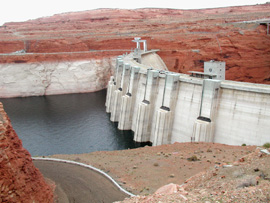Colorado River Users Face Potential Water Shortages
Interior Secretary Norton orders shortage guidlines and procedures for Lower Basin States to be prepared by May ‘05.
LeRoy W. Hooton, Jr.
December 22, 2004
|
The discussion about the drought sparked both conflict and pleas for cooperation to settle disputes among the water users. Speakers defended the 1922 compact and urged their cohorts to work out issues within the legal framework of the Law of the River. The drought was not yet characterized as a crisis, but planning for its continuation was described as prudent. No one was willing to predict when the drought will end.
The subject of “shortage” permeated the discussions. “It’s the goal of Secretary Norton during 2005 to have guidelines and procedures in place (for the first time) to reduce deliveries to the Lower Basin,” said Bureau of Reclamation Commission John Keys. He noted that in the Annual Operation Plan the Secretery has determined next year to be a “Normal” year; however, [Reclamation] hydrological studies indicate that the Colorado River will face shortages some day and [Reclamation] needs to prepare for that eventuality. If there is going to be shortage allocations, the Republic of Mexico should be engaged in parallel discussions with the Lower Basin to reduce water deliveries from the Colorado River said Deputy Secretary of the Interior J. Stevens Griles.
The term “shortage” provoked a spirited debate between Central Arizona Project (CAP) President George Renner and Metropolitan Water District of Southern California Vice President Dennis Underwood. Renner complained that as a result of the 1968 federal legislation that funded the construction of CAP, Arizona was required to make its water rights during shortages on the Colorado River junior to California’s. He was urging changing the priorities so that all of the Lower Basin states shared in the shortages. “Arizona now takes 100 percent of the risk during periods of shortage,” said Renner. “Congress promised augmentations on the river when the ’68 Act was passed, but it never happened.” Underwood countered that it was better to cooperate on programs to augment the river than to change the priorities. According to Renner CAP has spent $225 million for ground water storage to protect itself from shortages.
Because of the nature of the compact, the Upper Basin states will not have shortage guidelines. The compact requires the rolling 10 year average of 7.5 MAF of water delivered to the Lower Basin. Despite the drought, stored water in Lake Powell is providing these deliveries to the Lower Basin. “The compact is function just fine,” said Utah Division of Water Resources Executive Director D. Larry Anderson, “as long as water is available in Lake Powell and the Lower Basin gets its rolling average, there will be no call on Upper Basin water under the compact.”
The Las Vegas area is still growing at a rapid rate with 6,000 to 7,000 new residents per month. With only a 300,000 acre-foot apportionment of water from the Colorado River, the Southern Nevada Water Authority has taken strong conservation measures to cope with the drought. According to General Manager Pat Mulroy water usage declined by 20 percent from 2002 to 2004, reducing the volume of water from 325,000 acre-feet consumed to 260,000 acre-feet. The Authority has been providing incentives to eliminate grass landscapes in an area that receives about 4-inches of precipitation annually. Mulroy also championed cooperation between the various interests along the Colorado River. The Authority has entered into agreements with both Arizona and California for banking water. Mulroy referred to the success of these agreements as examples of how “cooperation makes things work.” She used another example of cooperation regarding the declining water level in Lake Mead and the necessity to again lower the Authority’s intake to its treatment plant. “We could go to the mat and not allow the level [in Lake Mead] to drop. We’re willing to move the intake down another 50 feet – none of us want to go to court, nobody wins,” she said.
The snowpack in the Colorado River drainage is slightly above normal at 114 percent; however Commissioner Keys warned that the snowpack was good early last year, only to melt away because of a warm spring. David Brandon, NOAA Chief Hydrologist in Charge noted that there is a weak El Niño developing in the Pacific that could affect weather patterns. He projected that the most probable Colorado River run-off is 7.3 MAF.
